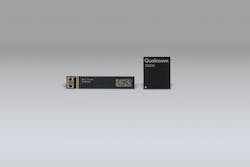Qualcomm, trying to strengthen its stronghold on the market for 5G chipsets, rolled out a more advanced 5G baseband modem that will be used in smartphones by early 2021. The Snapdragon X60 modem can be used to connect to any 5G network in the world where its customers sell smartphones. It lifts the performance floor of global 5G networks by combining more of the frequency bands used in 5G.
The X60 modem boosts the average speed and coverage of 5G networks compared with the company's last generation of 5G modems, the X55. The new modem takes advantage of the 5-nanometer node, which is set to become the most advanced chip technology this year, resulting in a smaller footprint and more energy efficiency. The X55, introduced in early 2019, is manufactured on TSMC's 7-nanometer node.
The X55 and X60 can handle both types of frequency bands used by 5G technology. That includes the sub-6 bands ranging from 600 MHz to 6 GHz that transfer data over longer distances but support more stagnant speeds. These bands are also shared by current 4G networks. In addition, the modems can handle the faster millimeter waves, which are currently only rolled out in dense urban areas due to signal limitations.
But the X60 also adds carrier aggregation, which is widely used by 4G networks, so that it can send data over both 5G frequency bands at the same time. By broadcasting over sub-6 bands and millimeter waves at once, the baseband processor can offer faster data transfers, said Qualcomm. It also incorporates CA for FDD and TDD bands in the 600 MHz-to-6-GHz range, raising throughput for 5G networks based on sub-6 bands.
The modem supports data transfers of up to 7.5 Gb/s and upload speeds of up to 3 Gb/s, according to Qualcomm. Using advanced CA technology, the X60 modem can double the speed of transmissions on the sub-6 bands when compared to the X55 modem, which can only support 4G LTE aggregation. The chip also supports sending phone calls over 5G networks—Voice over New Radio (VoNR)—instead of 3G or 4G.
The X60 will be only slightly faster than the X55, which is currently the world's most advanced 5G chipset. The X55 modem supports data rates of 7 Gb/s and upload speeds of 3 Gb/s, and it will be featured in flagship 5G smartphones rolling out in 2020. By broadcasting signals over a broader range of 5G frequency bands at once, the X60 modem improves the average speeds consumers actually see, Qualcomm said.
Christiano Amon, Qualcomm's second-in-command behind Steve Mollenkopf, said the X60 modem would speed the rollout of standalone (SA) 5G networks. Today, every 5G network is rolled out on legacy 4G LTE infrastructure—called non-standalone (NSA) networks—to boost throughput. The 5G NR standard is used to upgrade 4G networks without using costly new infrastructure, including tiny routers clustered throughout cities.
Qualcomm plans to start selling the modem chip in early 2020. But the most advanced tools in its arsenal will not be rolled out to 5G networks before late 2020. More than 45 telecommunications firms, including all the largest players in the US, are sprinting in the global race to install 5G new networks. In China, the scale of the national 5G network could surge more than 10 times by the end of 2020, according to Qualcomm.
The San Diego, California-based company is looking to expand its early dominance in 5G, which it believes will rejuvenate the slumping smartphone market. Qualcomm, long the world's largest vendor of mobile chips, forecasts global 5G unit shipments of 175 million to 225 million in 2020 as more 5G networks are rolled out. Today, more than 275 designs are on the market or in development with its 5G chipsets.
The X55 modem, which also supports standalone 5G networks, will be rolled out in 5G smartphones from Xiaomi, Oppo, and Vivo in the first half of 2020. The company's first generation of 5G modems, the X50, can only connect to 5G networks. It is integrated in the first flagship 5G smartphones sold by Samsung and LG in early 2019. None of its rivals currently sell chips that can handle both sub-6 bands and millimeter waves.
Qualcomm, looking to reduce the premium prices of 5G smartphones, has also started integrating 5G modems into its products. The company's first integrated 5G modem, the X52, supports all frequency bands used globally by 5G networks. But incorporating it into a single system-on-chip (SoC) requires some compromises. The modem's maximum speed is around half the speed of the X55 modem, Qualcomm said.
The company said the X60 modem can be paired with a new millimeter-wave antenna module, one of the most important components in 5G smartphones today. The module, QTM535, is more compact and delivers more performance than the second-generation QTM525, which handles the 26-, 28-, and 39-GHz bands. That leads to thinner 5G phones. Qualcomm said it started shipping QTM535 to early customers.
One of the problems with millimeter waves is that they only travel very short distances. The signals can also be blocked by hard surfaces, ranging from windows to walls. Simply holding your hand over the antenna can scramble the signal. Today, phone manufacturers place modules all around the edges of the phone. When one of the millimeter-wave antennas is blocked, the others can be used to tune into 5G networks.
Qualcomm is also trying to persuade customers to purchase more of its RF ICs surrounding the 5G baseband instead of integrating parts from separate vendors. As part of the strategy, Qualcomm rolled out its new category of RF filters, ultraSAW, for use in 5G smartphones. Plans are to package the high-performance filters in small modules that should be used in 5G handsets by the end of the 2020.
Qualcomm said the X60 would be used in 5G smartphones targeted to hit the market in 2021.
About the Author
James Morra
Senior Editor
James Morra is the senior editor for Electronic Design, covering the semiconductor industry and new technology trends, with a focus on power electronics and power management. He also reports on the business behind electrical engineering, including the electronics supply chain. He joined Electronic Design in 2015 and is based in Chicago, Illinois.


